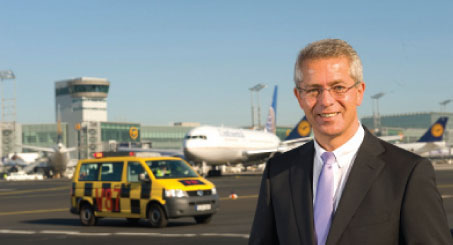
Schulte: “Today, Fraport is a very strong company and our FRA home base is well positioned, with new capacity coming on stream to take advantage of fresh growth coming after the recent global financial and economic crisis. Our development of FRA and Fraport as a diversified business with aeronautical and non-aeronautical business pillars has been important, too.”
It was 75 years ago, in 1936, that Frankfurt’s current airport opened adjacent to Germany’s first autobahn intersection – the famous Frankfurter Kreuz, which today handles around 300,000 vehicles daily. “Location, location, location! We are ideally located in the heart of Germany and Europe, close to the city of Frankfurt, and at the junction of major air, rail, road and water transportation networks,” said Schulte.
There have been many milestones over the years. Frankfurt Airport (FRA) played a pivotal role as the main air hub for the Berlin Airlift of 1948-49 – still the biggest humanitarian airlift in history. The airlift underscored the strategic role of the airport’s central location and its logistics potential. “Incidentally, today we are the busiest air cargo hub in Europe and among the top 10 worldwide,” commented Schulte.
The parallel north and south runways were completed in 1949 and by 1955, Lufthansa was relaunched and became FRA’s largest carrier. The integrated Central Terminal, including a railway station and automated baggage handling system, opened in 1972 – it formed the basis of Fraport’s pioneering intermodal air-rail effort. Terminal 2 was inaugurated in 1994 and CargoCity South was created in the late 1990s.
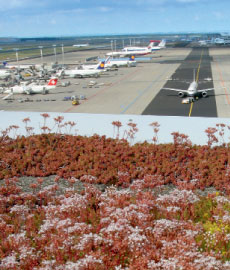
Frankfurt Airport is currently at the ‘Reduction’ level of Airport Carbon Accreditation. Indeed, it was the very first airport to become Airport Carbon Accredited, in September 2009 and is currently working diligently on progressing to the next level – ‘Optimisation’.
The Frankfurt Airport company became Fraport AG and went public with an IPO in June 2001. Fraport has developed into a global airport manager with a family of 13 airports that are owned and/or managed by Fraport worldwide.
“Starting at Fraport as CFO and then taking over the helm as CEO almost two years ago, I have some personal highlights. Strengthening the company and the airport for the ups and downs of the industry and the global economy has been challenging but essential,” explained Schulte. “Today, Fraport is a very strong company and our FRA home base is well positioned, with new capacity coming on stream to take advantage of fresh growth coming after the recent global financial and economic crisis. Our development of FRA and Fraport as a diversified business with aeronautical and non-aeronautical business pillars has been important, too.”
Fraport will celebrate its 75th anniversary with a unique event to be held on the new Runway Northwest on 25 and 26 June. The event – ‘Happy Landings’ – will celebrate past achievements and future opportunities. 60,000 people from the region, plus 20,000 airport staff with families, will enjoy a static display of aircraft, a multimedia pavilion, live music, live radio and TV broadcasts, as well as exhibition stands from various Fraport departments and airport partners.
Year of growth
In all respects, 2010 can be described as a year of growth for Fraport. The growth momentum has significantly improved profitability, which is important in terms of handling the financial burden of Frankfurt Airport’s huge expansion programme. The airport’s throughput rose by +4% in 2010 to 53 million passengers – an excellent result given that European flights were grounded for several days due to April’s ash cloud crisis, coupled with the severe winter weather at the beginning and end of the year. A record volume of air cargo – 2.2 million tonnes – was also achieved. These figures led to a +9.2% increase in Group revenue to €2.2 billion.
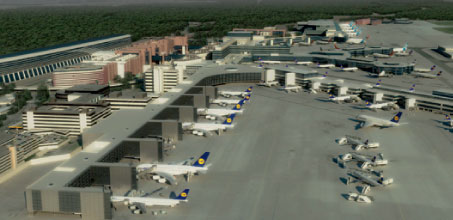
Pier A-Plus will provide seven new parking positions for widebody aircraft, including four for the A380. Looking further ahead, plans are also underway for the new Terminal 3, the first phase of which is scheduled to be complete in late 2016 or early 2017.
The latest figures for April show +6.7% year-on-year growth of 250,000 passengers. “We have seen a gradual recovery in the global economy. Frankfurt has naturally benefitted from this too. The German economy has proven to be robust and international exports remain strong, particularly in emerging markets. Thanks to our huge global route network and numerous carriers at FRA – and a strong home base carrier and system partner in Lufthansa (LH)/Star Alliance – we have rebounded quickly and strongly from the economic crisis that also hit aviation hard,” said Schulte.
The October opening of the new Runway Northwest is undoubtedly the most important contribution to securing Frankfurt Airport’s competitive future. It will initially increase the airport’s runway capacity from 82 to 90 movements per hour – and eventually by 50% to more than 120 movements per hour. In the medium-term, the airport’s plans foresee increasing capacity to around 100 movements per hour by 2015 – and with expected annual traffic growth of +4-7%, Frankfurt Airport could be handling 65 million passengers per year by that time.
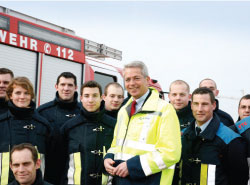
Dr Stefan Schulte, Chairman of the Executive Board, Fraport AG, pictured with new Fraport trainees for the FRA Fire Department, who have been recruited because of the capacity expansion at Frankfurt Airport.
Schulte explained that the new runway will enable Fraport to increase flight frequencies on certain routes, add new destinations and attract new airlines to FRA. “The new capacity is driving the evolution of FRA into a dynamic airport city. KPMG has just transferred more than 2,100 staff, consolidating various Frankfurt area offices to The Squaire complex at Frankfurt Airport. Simultaneously, KPMG has designated FRA as its new European headquarters, which was formerly based in London,” he said. “The phased 50% increase in runway capacity opens up tremendous opportunities for the many existing players at FRA, as well as new entrants interested in the location and operational advantages of our growing mega-hub. First and foremost, FRA is an intercontinental transfer hub for network carriers and not really suited to low-cost airlines. The LH/Star Alliance carriers currently account for about two-thirds of the traffic at FRA.”
€7bn investment
Terminal infrastructure is also being developed – notably the westward extension of Terminal 1, which is known as Pier A-Plus. The project will be complete in 2012, increasing the terminal’s annual capacity by 6 million passengers. Pier A-Plus will provide seven new parking positions for widebody aircraft, including four for the A380. Looking further ahead, plans are also underway for the new Terminal 3, which will have an annual capacity of 25 million passengers. The first phase of Terminal 3 is scheduled to be complete in late 2016 or early 2017.
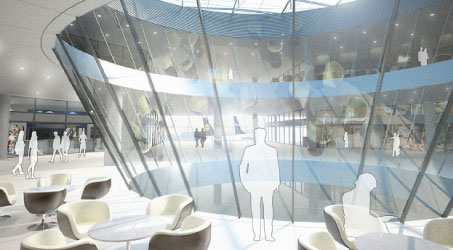
An impression of the Pier-A Plus Atrium, which will be the architectural highlight of the extension to Terminal 1. The project will be complete in 2012, increasing the terminal’s annual capacity by 6 million passengers.
In recent years, Fraport’s annual investment has reached or exceeded €1 billion per annum. “Even during the economic crisis we continued investing in our new runway and other infrastructure projects. If you add in the investments made by Lufthansa and other airport users, major real estate developments like The Squaire, Gateway Gardens, and the Mönchhof logistics park, this investment volume at FRA exceeds well over €10 billion,” explained Schulte.
Pier A-Plus will be used exclusively by Lufthansa and the needs of LH as exclusive tenant have been taken closely into consideration. “We are the owner and operator of passenger terminals at FRA, so naturally this means we work closely with users of these facilities. In the past, we have worked closely with Lufthansa concerning the redevelopment and extension of various areas of Terminal 1,” commented Schulte. “We have also worked closely with major retailers like Heinemann at the new Pier A-Plus. Basically, airport facilities need to take into account functionality, quality and attractiveness for the passengers, flexibility for the future, economics of construction and maintenance, environmental aspects and, last but not least, the requirements of commercial partners on the airport site.”
Detailed planning will commence shortly for the new Terminal 3 – a demand-driven facility to be built in phases. Construction is scheduled to start in 2013 and the first phase is expected to go into operation in 2016/2017.
FRA has also made additional investments in its winter contingency. A second new de-icing pad near the main takeoff runway went into operation last year and the airport is looking at new de-icing areas. “Our fleets of de-icing and snow-clearing equipment will be expanded and we will add more winter services staff. Generally speaking, we met the 2010 winter challenge quite well, but there is room for improvement and we have to meet the requirements of adding a runway and taxiways – and serving more aircraft,” said Schulte.
International operations
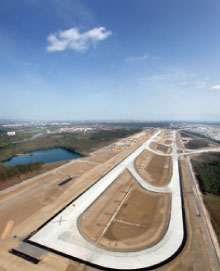
The October opening of the new Runway Northwest is undoubtedly the most important element in securing Frankfurt Airport’s future.
Fraport’s portfolio of 13 airports includes majority-owned airports (Frankfurt, Antalya, Lima, Burgas and Varna), as well as minority-owned airports (Hanover, Delhi, St Petersburg and Xi’an) and airports where it has a management contract (Cairo, Riyadh, Jeddah and Dakar).
“Growth in foreign markets helped us weather the traffic and economic storms in the past, but Frankfurt is poised for more growth in the future thanks to our timely capacity expansion,” explained Schulte. “Simultaneously, our strategy is to continue growing our external business beyond Frankfurt. We are constantly on the lookout for opportunities worldwide. We are not a finance investor – like a bank for example – but are interested in more majority stakes so that we can bring the full extent of our expertise into play. Many projects in Brazil, Europe and elsewhere have been tentatively announced to the marketplace, but nothing concrete is out there yet. We will have to wait and see which projects are interesting to us, which models are being offered by various governments, and which ones we could win.”
360° Environmental Strategy
Frankfurt Airport is currently at the ‘Reduction’ level of Airport Carbon Accreditation. Indeed, it was the very first airport to become Airport Carbon Accredited, in September 2009 and is currently working diligently on progressing to the next level – ‘Optimisation’. In February, FRA became the fourth airport in Europe to fully implement Airport Collaborative Decision-Making, which will help optimise operations and shorten aircraft taxi times. The new buildings at FRA feature energy saving and carbon reducing technologies and concepts. For example, its first carbon neutral building is Fire Station 4, which has been built next to Runway Northwest. Fraport’s overall goal at FRA is to reduce CO2 emissions per traffic unit (one passenger or 100kg of freight) by 30% by 2020.
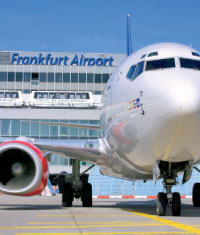
Frankfurt Airport’s throughput rose by +4% in 2010 to 53 million passengers – an excellent result given that European flights were grounded for several days due to April’s ash cloud crisis, coupled with the severe winter weather at the beginning and end of the year. The latest figures for April 2011 show +6.7% year-on-year growth of 250,000 passengers.
Other initiatives include protecting the biodiversity of plants and animals, and major reforestation to offset trees cut down for the expansion programme. Underlying all of this, Fraport has created a Sustainability Management department to link sustainable principles throughout the airport company and other stakeholder partners at FRA. “We are very active in a wide range of environmental initiatives, but noise is obviously the one area that generates the most concern from our neighbours. The lengthy and extensive approval phase for the Airport Expansion Program has dealt with these issues in detail,” said Schulte. “We are pushing ahead with our active noise abatement programme and stay in close dialogue with concerned neighbours. The reconfiguring of flight routes, due to the implementation of the new runway later this year, is a growing issue that has been addressed. The success of noise reduction via new engine and aircraft technologies has to be explained even more in the future.”
Fraport also considers SESAR to be vital for Europe. It is directly involved in SESAR as a partner in the SEAC consortium of major European airports. Recently, SEAC won a SESAR innovation award for its Project 6.5.1 (‘Airport operations plan definition’). This project developed a new approach in bridging airport operations with air traffic control, with the goal of developing the link between the Airport Operations Center and the ATM Network.
Enhancing the airport experience
Fraport is continuing its successful ‘Great to Have You Here!’ top-quality and customer service initiative, which is focused on improving service and the airport experience at Frankfurt. The focus in the past year has been on shortening waiting times at security checkpoints; more than 90% of passengers now wait less than 10 minutes.
Commenting on the LAGs (liquids, aerosols and gels) issue, Schulte said: “There has been some confusion among the travelling public on this issue, which makes it more difficult for airports and airlines to serve passengers as efficiently and safely as possible. Security will continue to be a challenge in the future, but advances in technology should help. However, the security chain depends on well thought-out and well-implemented procedures and appropriate technologies in tandem with security staff who should provide friendly and effective services.”
After a complex multi-year planning-approval phase, Fraport started implementing its Airport Expansion Program in 2009. The massive capacity expansion and redevelopment of FRA’s existing terminal facilities will strengthen its position in the future. Fraport wants to maintain its role as one of the leading international hubs in global aviation, and to earn a good share of the future growth in aviation. “Now, with our new runway opening later this year and future terminal expansions in 2012 and beyond, we are on the threshold of a new age of growth. Building on our history, we have a very exciting future ahead of us,” concluded Schulte.
Lufthansa: ‘Airports and airlines are system partners’
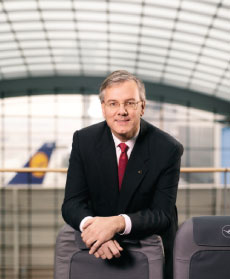
Dr Christoph Franz, Lufthansa Group Chairman and CEO: “Airlines and airports have acknowledged that they have to work together more closely to achieve the best customer satisfaction.”
Dr Christoph Franz was officially appointed Lufthansa Group Chairman and CEO on 1 January, having originally begun his career with Lufthansa in 1990. He gave Airport Business his perspective on a range of issues, including the airport-airline relationship, airline consolidation and Lufthansa’s strategy for ensuring sustainable, profitable growth.
The Lufthansa Airline Group includes five carriers – Lufthansa, Austrian Airlines, bmi, Brussels Airlines and SWISS – operating services via hubs at Brussels, Düsseldorf, Frankfurt, London Heathrow, Munich, Vienna and Zurich. Together they currently serve 283 destinations in 105 countries, and carried 22.1 million passengers in Q1 2011 – up +6.9% year-on-year.
Lufthansa’s strategy for offering a global network and seamless travel is centred on a combination of organic growth, forming alliances and adding airlines to the Group, which were already leaders in their home markets and had additional exposure to emerging markets. “Right now we are focusing on organic growth, which means adding capacity and offering new destinations. But that does not mean that we rule out other ways to grow,” commented Franz.
He believes that, with the recent merger of British Airways and Iberia, the level of airline consolidation activity within Europe has peaked. “Therefore most players will be looking at the airlines in growth markets. But with regulatory frameworks that make it difficult to take a majority position outside Europe, we need the political will to form the basis for further consolidation.”
Franz also said that airports and airlines have to become real system partners, sharing benefits as well as risks in a well-balanced way. “Airlines and airports have acknowledged that they have to work together more closely to achieve the best customer satisfaction. We need more and intensive collaboration to increase flexibility and speed.”
Indeed, Lufthansa and Fraport have collaborated closely on the Pier A-Plus at Frankfurt Airport’s Terminal 1, which will open in summer 2012, ensuring the facility is tailored to market needs.
Service on the ground is increasingly important and, according to Franz, providing these services is becoming more challenging with passenger numbers increasing, while airport capacity is limited. “The passenger’s needs are obvious: short waiting time, simple processes, getting information fast and being offered solutions in case of irregularities.”
Looking to the future, Franz said: “Our home market is Europe; our growth market is the world. We are always looking into new possibilities to grow and this strategy also applies for long haul routes. There the growth is much more dynamic, especially into traffic regions like Asia-Pacific or Africa and the Middle East.”







